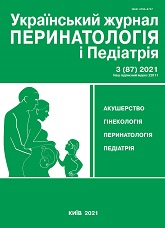Clinical case of sharp bowel obstruction during pregnancy for a patient with an extracorporal impregnation and large intergenic interval
DOI:
https://doi.org/10.15574/PP.2021.87.77Keywords:
sharp bowel obstruction, pregnancy, extracorporal impregnation, large intergenic intervalAbstract
The great importance in the development of acute intestinal obstruction (AIO) is the change in intestinal kinetics during pregnancy. In pregnant women, the rhythmic function of the intestine slows down due to an increase in the threshold of excitability of its receptors to biologically active substances. The article provides an overview of modern literary sources on the problem of acute intestinal obstruction in pregnant women. According to foreign literature sources, the incidence of intestinal obstruction in pregnant women is 1:3600–1:66000, and complications of diseases of the digestive system rank 4th among the causes of maternal mortality during pregnancy — 9%. According to domestic scientific sources, the frequency with which intestinal obstruction occurs in pregnant women is 1:40000–1:50000 births, mortality reaches 35–50%, stillbirth — 60–75%.
The development of the disease is caused by physiological changes in the body of a pregnant woman. With increasing gestational age there are changes in the anatomical arrangement of the abdominal organs. From the second trimester of pregnancy, the uterus extends beyond the pelvis and gradually occupies the entire abdominal cavity. The increase in the size of the uterus due to hypertrophy and hyperplasia of muscle fibers, amniotic fluid, fetal growth, leads to increased intraabdominal pressure, displacement of the small intestine and lumbar colon up, thereby creating conditions for compression of intestinal loops, nodules, development. The modern classification, clinic, diagnostics and methods of treatment of this surgical pathology are presented.
The author presents his own clinical case of acute intestinal obstruction in a 51-year-old pregnant woman with the sixth desired pregnancy, which occurred as a result of assisted reproductive technologies and a large intergenetic interval.
Both surgeon and obstetrician-gynecologist treat intestinal obstruction in pregnant women. Conservative treatment is carried out simultaneously with diagnostic procedures. No effect of conservative therapy for 2 hours is an indication for surgery. The main purpose of surgery is to eliminate the causes of intestinal obstruction and restore bowel function. The scope of surgery is determined in each case individually and depends on the type of AIO and the age of the disease. The chosen tactics of the preoperative period, the volume of surgery, anesthesia and adequate management of the postoperative period can cure acute surgical pathology, maintain the desired pregnancy, avoid the development of obstetric and surgical purulent-septic complications.
The research was carried out in accordance with the principles of the Helsinki declaration. The informed consent of the patient was obtained for conducting the studies.
No conflict of interest was declared by the authors.
References
Busch FW, Hamdorf JM, Carroll CS Sr et al. (2004). Acute colonic pseudo - obstruction following cesarean deliver. J Miss State Med Assoc. 45 (11): 323-326.
Fadiora SO, Olatoke SA, Bello TO et al. (2004). Intestinal obstruction from a forgotten aftery forceps: a case report. West Afr J Med. 23 (4): 330-331. https://doi.org/10.4314/wajm.v23i4.28150; PMid:15730094
Hauspy J, Roofthooft N, Meulyzer P, Leyman P. (2004). Small bowell obstruction during pregnancy. Acta Chir Belg. 104 (5): 588-590. https://doi.org/10.1080/00015458.2004.11679621; PMid:15571030
Kalu E, Fakokunde A, Jesudason M, Whitlow B. (2005). Acute colonic pseudo - obstruction (Ogilvie's Syndrome) following cesarean section for triplets. J Obstet Gynaecol. 25 (3): 299-300. https://doi.org/10.1080/01443610500105928; PMid:16147743
Downloads
Published
Issue
Section
License
The policy of the Journal “Ukrainian Journal of Perinatology and Pediatrics” is compatible with the vast majority of funders' of open access and self-archiving policies. The journal provides immediate open access route being convinced that everyone – not only scientists - can benefit from research results, and publishes articles exclusively under open access distribution, with a Creative Commons Attribution-Noncommercial 4.0 international license(СС BY-NC).
Authors transfer the copyright to the Journal “MODERN PEDIATRICS. UKRAINE” when the manuscript is accepted for publication. Authors declare that this manuscript has not been published nor is under simultaneous consideration for publication elsewhere. After publication, the articles become freely available on-line to the public.
Readers have the right to use, distribute, and reproduce articles in any medium, provided the articles and the journal are properly cited.
The use of published materials for commercial purposes is strongly prohibited.

